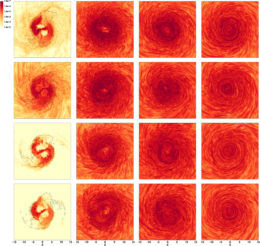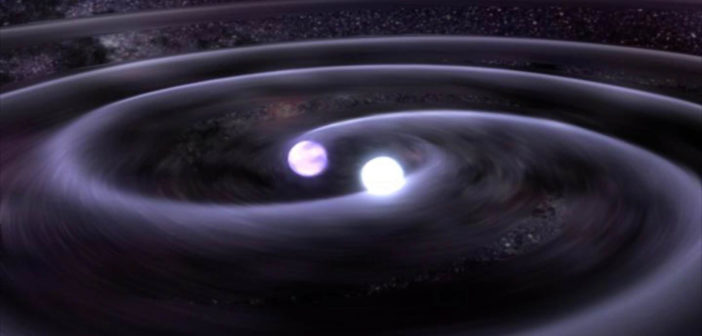The merger of two neutron stars releases an enormous amount of energy and reconfigures the magnetic field of the whole binary system. How well do we need to know the initial conditions of the system to predict the outcome of the merger?
When Worlds Collide
In 2017, the Laser Interferometer Gravitational-Wave Observatory (LIGO) made the first observation of a neutron star–neutron star merger by detecting the ripples in spacetime released as the two massive objects collided and sent the signal ringing through the cosmos. This detection showed that neutron star–neutron star mergers are powerful enough to emit gravitational waves and allowed us to observe properties of these neutron stars such as their mass and radius.

Magnetic field evolution over the course of the merger. Time increases from left to right, showing snapshots at 2, 5, 10, and 20 milliseconds after the merger. Each row is a different simulation, and the darker the area in the image, the more intense the magnetic field. [Aguilera-Miret et al. 2022]
Does the End Point to the Means?
Though the dynamics of colliding neutron stars are fairly well understood, a few open questions remain, such as how the magnetic field amplifies and reorganizes during the merger. This is important because the amplification and reorganization is necessary for the production of the jet associated with short gamma-ray bursts.
Studying this critical process is difficult, as it involves capturing fluctuations and instabilities on a very small scale and requires precise knowledge of the initial parameters of the system. A team led by Ricard Aguilera-Miret (University of the Balearic Islands / Institute of Space Studies of Catalonia) performed complex simulations to tackle the question of how much the initial magnetic field configuration of the system affects the end product of the merger.

The magnetic field energy for various simulations. This shows that no matter what energy the system begins with, the final energy will be roughly the same. [Aguilera-Miret et al. 2022]
Magnetic Merging
Using supercomputers, the team explored the effect of different initial magnetic configurations on the final magnetic field strengths of the simulated binary neutron star mergers. As they moved time forward, exploring up to 30 milliseconds after the merger, they found that the initial topology of the system does not affect the end product because small-scale turbulence erases any memory of magnetic fields greater than 1012 G within a few milliseconds of the merger. This creates a new conundrum, as it shows that we can’t infer the initial magnetic field of a system by observing it post-merger.
These simulations show that using a simplified magnetic field model is acceptable in binary neutron star mergers, as long as the magnetic field isn’t too large, because it doesn’t make a difference in the final configuration. Further observations of neutron star–neutron star mergers will provide a test of this theory.
Citation
“Universality of the Turbulent Magnetic Field in Hypermassive Neutron Stars Produced by Binary Mergers,” Ricard Aguilera-Miret et al 2022 ApJL 926 L31. doi:10.3847/2041-8213/ac50a7
